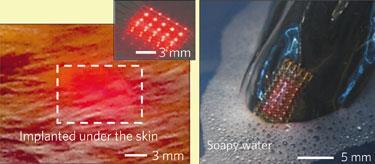Flexible sheets of tiny LEDs could be implanted under the skin like glowing tattoos and used in a range of biomedical applications
An international team of researchers has developed flexible sheets of tiny light emitting diodes (LEDs) that could be implanted under the skin like glowing tattoos and used in a range of biomedical applications.
John Rogers at the University of Illinois at Urbana-Champaign, US, worked with researchers in the US, Korea, China and Singapore to build on his previous work on flexible circuits and ultra-thin LEDs.
To make the new LEDs, the team worked with arrays 100 x 100um in size and just 2.5um thick, several times smaller than any similar commercially available devices. The researchers printed the circuits onto a rigid glass substrate before transferring them to poly(dimethylsiloxane) (PDMS), a low cost, flexible biocompatible polymer.

Most recent research on flexible LED circuits has focused on organic LEDs (OLEDs) but Rogers argues that his approach has benefits for biomedical applications. ’I wouldn’t necessarily characterise this approach as better [than OLEDs],’ he says, ’OLEDs are extremely sensitive to oxygen or water, but we encapsulate our device in a thin layer of silicon rubber. The brightness, lifetime and the ability to make them in a waterproof form distinguishes our devices.’ To demonstrate the array’s ability to function in these environments, Rogers and his team integrated the miniature LEDs into the fingertip of a vinyl glove and immersed it in soapy water, and implanted an LED array beneath the skin in an animal model.
The hope is that these new devices will find a variety of applications, including as suture threads or implantable patches that could perform spectroscopy to characterise bodily tissue, or be used in sophisticated diagnostics and to monitor wound healing. The arrays could also be used in photodynamic drug therapy, to control the delivery of drugs that are triggered by light in a more precise way.

’We’re used to thinking of electronic devices as distinct from things we wear or put over our wounds to heal them’ says Michael Strano, of the chemical engineering department at Massachusetts Institute of Technology, Cambridge, US. ’Nobody knows what’s going to come from a lot of this work, but it’s going to have an enormous impact.’
Rogers has recently launched a spin out company, to work on commercialising some of his devices, a goal he sees as ’incredibly appealing’. ’We try to choose problems in science where the solutions can have an impact on society through commercialised products,’ he says. ’I want to see this stuff have impact - it’s the end goal that’s serving as a motivation.’
Laura Howes
References
et alNature Materials, 2010, DOI: 10.1038/nmat2879






No comments yet